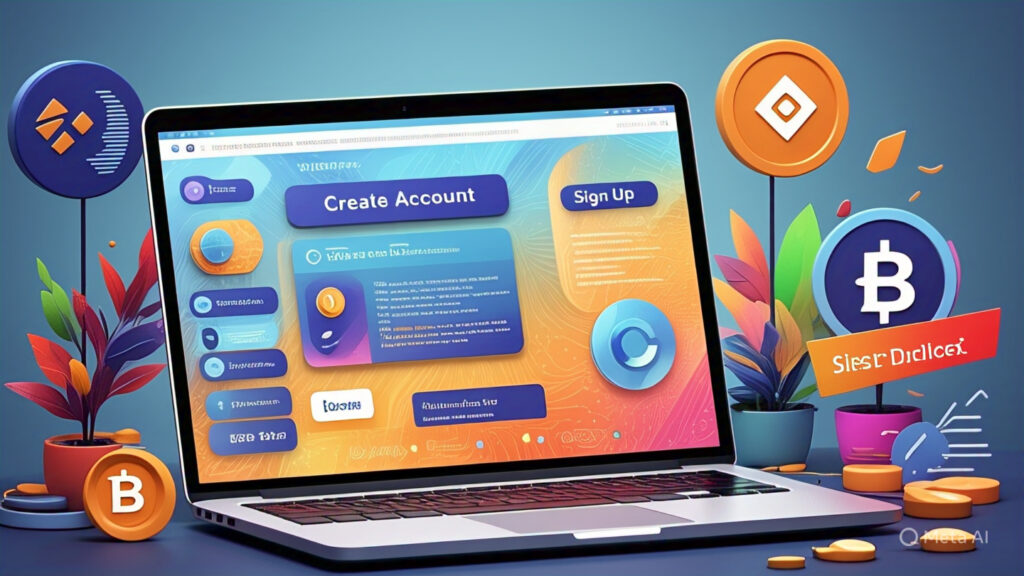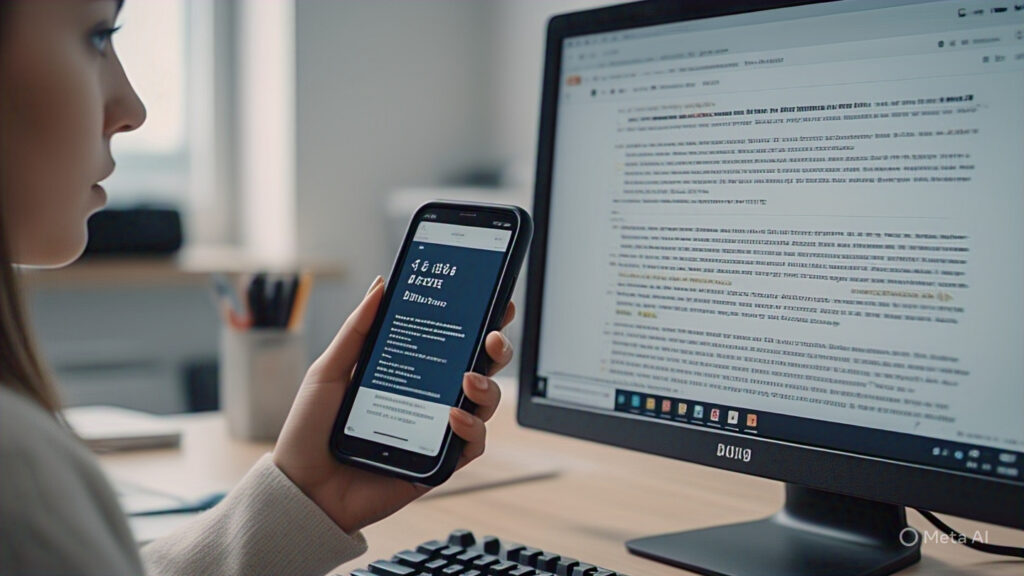Introduction: Taking Your First Step into the Cryptoverse
So, you’re ready to dive into the exciting world of cryptocurrencies! You’ve done some research, you’re intrigued by the potential of Bitcoin, Ethereum, or maybe even some of the emerging altcoins. The next logical step? Setting up an account on a cryptocurrency exchange – your primary gateway to buying, selling, and trading digital assets.
Think of a crypto exchange as a digital marketplace, similar to a stock exchange, but specifically for cryptocurrencies. It’s a platform where buyers and sellers meet to exchange fiat currencies (like US dollars or Euros) for various cryptocurrencies, and vice versa, or to trade one cryptocurrency for another.
However, navigating the process of setting up your first exchange account can sometimes feel a little daunting. With various platforms available and security being a paramount concern, it’s essential to approach this step with care and understanding.
This article will serve as your friendly guide, walking you through the entire process of setting up your first crypto exchange account. We’ll break down each step in a clear, humanized way, highlighting important considerations, security tips, and what to expect along the way. By the end of this guide, you’ll feel confident and well-equipped to take your first step into the fascinating world of digital currencies.

Choosing the Right Crypto Exchange: Laying a Solid Foundation
Before you even begin the signup process, one of the most crucial steps is selecting the right cryptocurrency exchange for your needs. With numerous platforms available, each with its own features, fees, security measures, and supported cryptocurrencies, careful consideration is key. Here are some important factors to consider:
- Reputation and Security: Look for established exchanges with a strong track record of security and reliability. Research their security protocols, past incidents (if any), and user reviews.
- Supported Cryptocurrencies: Ensure the exchange offers the specific cryptocurrencies you are interested in buying, selling, or trading.
- Fees: Understand the exchange’s fee structure, including trading fees, withdrawal fees, and deposit fees. These can vary significantly between platforms.
- User Interface and Experience: Choose an exchange with a clean, intuitive, and user-friendly interface, especially if you’re a beginner. Some exchanges offer simplified interfaces for newcomers.
- Payment Methods: Check if the exchange supports your preferred payment methods for depositing and withdrawing funds (e.g., bank transfers, credit/debit cards, e-wallets).
- Regulatory Compliance: Opt for exchanges that comply with the regulations in your jurisdiction. This can offer an added layer of security and protection.
- Customer Support: See what kind of customer support the exchange offers (e.g., email, live chat, phone support) and read reviews about their responsiveness and helpfulness.
- Geographic Availability: Some exchanges may not be available in your country or region due to regulatory restrictions.

Step-by-Step Guide: Setting Up Your Account
Once you’ve chosen a cryptocurrency exchange that aligns with your needs, the account setup process generally follows these steps:
Step 1: Accessing the Exchange’s Website or App
The first step is to navigate to the official website of your chosen exchange or download their mobile application from a trusted app store (like Apple App Store or Google Play Store). Always double-check the website address to ensure you are on the legitimate site and not a phishing scam. Be wary of lookalike domains or links shared through unofficial channels.

Step 2: Initiating the Registration Process
Click on the “Sign Up,” “Register,” or “Create Account” button. You will typically be asked to provide some basic information, such as:
- Your Email Address: Use a strong and unique email address that you don’t use for less secure online activities.
- A Strong Password: Create a complex password that is difficult to guess. It should include a combination of uppercase and lowercase letters, numbers, and symbols. Avoid using personal information or common words. Consider using a password manager to generate and securely store your passwords.

Step 3: Email Verification
After submitting your initial information, the exchange will usually send a verification email to the address you provided. You will need to open this email and click on a verification link to confirm your email address. This step helps ensure that the email address you provided is valid and that you have access to it.

Step 4: Agreeing to Terms and Conditions
Like any online service, cryptocurrency exchanges have their own terms and conditions, privacy policies, and risk disclosures. It’s crucial to read these documents carefully before proceeding. Understand your rights and responsibilities as a user of the platform. Pay attention to clauses regarding fees, security, liability, and the risks associated with cryptocurrency trading.

Step 5: Identity Verification (KYC – Know Your Customer)**
Most regulated cryptocurrency exchanges are required to comply with Know Your Customer (KYC) regulations. This involves verifying your identity to prevent money laundering, fraud, and other illicit activities. The KYC process typically involves providing personal information and uploading identification documents.
- Personal Information: You will likely need to provide your full name, date of birth, residential address, and sometimes your occupation.
- Identification Documents: You will usually be required to upload a clear copy of a government-issued photo ID, such as your passport, driver’s license, or national ID card. Some exchanges may also require a proof of address document, such as a utility bill or bank statement.
- Selfie Verification: Some exchanges may also ask you to take a live selfie with your ID to further verify your identity.
Be prepared for this step to take some time. The verification process can sometimes take anywhere from a few minutes to several days, depending on the exchange and the volume of applications they are processing. Ensure the documents you upload are clear, legible, and meet the exchange’s requirements.

Step 6: Setting Up Two-Factor Authentication (2FA) – A Critical Security Step
Once your identity is verified (or even before you start trading), setting up Two-Factor Authentication (2FA) is absolutely crucial for the security of your account. 2FA adds an extra layer of protection beyond just your password. It typically requires you to provide a second verification code from a separate device, usually your smartphone, in addition to your password when you log in or perform sensitive actions like withdrawals.
Common 2FA methods include:
- Authenticator Apps: Apps like Google Authenticator or Authy generate time-sensitive codes that you need to enter.
- SMS Verification: The exchange sends a verification code to your mobile phone via SMS. While convenient, this method is generally considered less secure than authenticator apps due to the risk of SIM swapping.
We strongly recommend using an authenticator app for the highest level of 2FA security. Follow the exchange’s instructions carefully to set up 2FA. You will usually need to scan a QR code with your authenticator app and enter a verification code to link it to your account. Make sure to securely back up your 2FA recovery codes provided by the exchange. These codes will be essential if you lose access to your 2FA device.

Step 7: Exploring the Exchange Interface and Features
Once your account is set up and secured with 2FA, take some time to familiarize yourself with the exchange’s interface and features. Most exchanges offer sections for:
- Wallet/Funds: Where you can see your balances of different cryptocurrencies and fiat currencies, and manage deposits and withdrawals.
- Trading: Where you can buy and sell cryptocurrencies using different order types (e.g., market order, limit order).
- Charts and Market Data: Providing price information, trading volume, and historical data for various cryptocurrencies.
- Security Settings: Where you can manage your 2FA, view login history, and potentially set up other security measures.
- Support/Help Center: Where you can find FAQs, guides, and contact customer support if needed.

Step 8: Funding Your Account (Making Your First Deposit)**
Before you can start trading, you’ll need to deposit funds into your exchange account. The available deposit methods will vary depending on the exchange and your location. Common options include:
- Bank Transfers: Often with lower fees but can take longer to process.
- Credit/Debit Cards: Usually faster but may come with higher fees.
- Cryptocurrency Transfers: If you already own cryptocurrency in another wallet, you can usually deposit it into your exchange account.
- E-wallets: Some exchanges support deposits through e-wallet services.
Follow the exchange’s instructions carefully for your chosen deposit method. Be aware of any minimum deposit amounts and potential processing times.

Step 9: Making Your First Trade (Buying Cryptocurrency)**
Once your funds have been credited to your account, you’re ready to make your first cryptocurrency trade! Navigate to the “Trading” section of the exchange and select the cryptocurrency you want to buy and the trading pair you want to use (e.g., BTC/USD if you want to buy Bitcoin with US dollars). Enter the amount you want to buy and choose your order type. For beginners, a simple “market order” (buying at the current market price) is often the easiest way to start. Review your order carefully before confirming.

Important Considerations and Security Tips for Beginners
As you embark on your crypto trading journey, keep these important considerations and security tips in mind:
- Start Small: Don’t invest more money than you can afford to lose, especially when you’re just starting. Cryptocurrency markets can be volatile.
- Do Your Own Research (DYOR): Don’t blindly follow investment advice. Understand the cryptocurrencies you are investing in and the risks involved.
- Be Wary of Scams: The crypto space attracts scammers. Be cautious of unsolicited offers, promises of guaranteed high returns, and phishing attempts. Never share your private keys or seed phrase.
- Understand Fees: Be aware of all the fees associated with trading, deposits, and withdrawals on the exchange.
- Consider Using Limit Orders: As you become more comfortable, explore using limit orders to buy or sell cryptocurrency at a specific price.
- Don’t Leave Large Amounts on Exchanges: For long-term storage of significant amounts of cryptocurrency, consider transferring them to a more secure, non-custodial wallet where you control your private keys (like a hardware or software wallet).
- Keep Your Software Updated: Ensure your operating system, browser, and exchange apps are always up to date with the latest security patches.
- Educate Yourself Continuously: The world of cryptocurrency is constantly evolving. Stay informed about new developments, security best practices, and potential risks.

Conclusion: Your First Step Towards Digital Assets
Setting up your first cryptocurrency exchange account is an exciting and crucial step in your journey into the world of digital currencies. By choosing a reputable exchange, carefully following the registration and verification process, prioritizing security by enabling 2FA, and understanding the basics of funding your account and making trades, you’ll be well on your way to participating in this innovative financial landscape.
Remember to approach this new venture with caution, prioritize security at every step, and never stop learning. The world of cryptocurrency offers immense potential, and with a solid foundation and a commitment to security, you can navigate it with confidence and explore the exciting opportunities it holds. Welcome to the crypto community!



